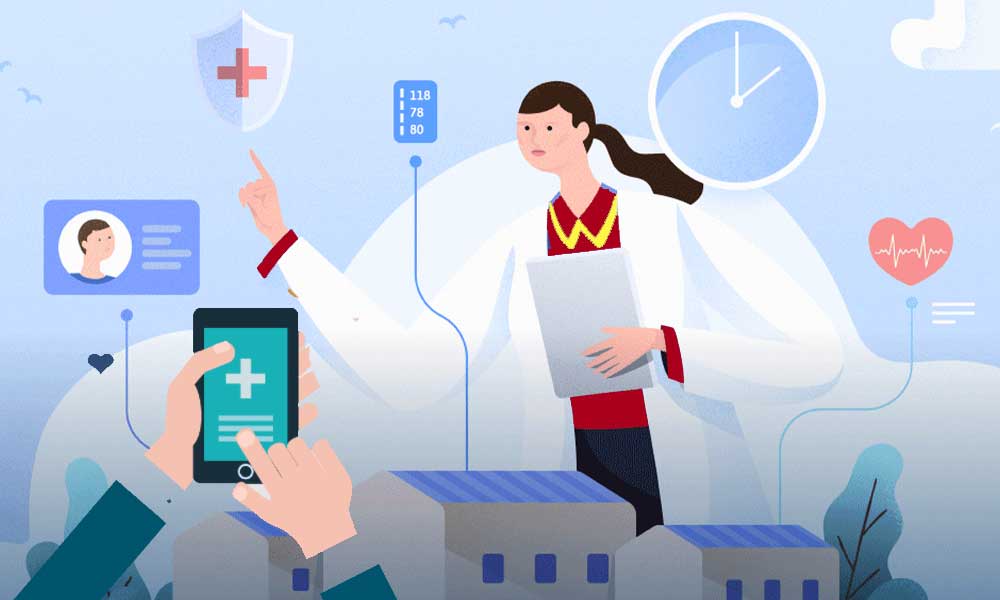Healthcare has long been embarked on the course of digitization. But the pandemic has sparked special interest in information technology and medical applications. Hospitals and clinics have realized that they need IT technologies to help them optimize their services under immense pressure. Patients want to be monitored remotely to avoid personal visits to clinics where they can catch the coronavirus from others. Mobile applications for health care have become a vital necessity. But the fight against COVID-19 is not the only problem that digital products can solve. In this article, we will consider how healthcare software development is transforming the industry.
Problem 1: Patients need online consultations
Traditionally, health consultations are held tête-à-tête. To receive treatment, a patient must visit a doctor in person at the nearest medical center. The elderly, people with disabilities, and residents of remote areas experience difficulties in obtaining personal appointments. Since the beginning of the pandemic, quarantined patients have been added who do not want to visit clinics so as not to contract the coronavirus. People need online consultation and remote health monitoring. They want to get professional medical help and stay safe at the same time.
Custom telehealth software helps solve this problem. Remote consultation software solutions connect a patient with a doctor through video calls and messengers. The system works on smartphones, smart tablets, laptops and personal computers. Such software is integrated with IoT devices to collect data on blood pressure, blood oxygen level, heart rate, and other vital signs. The doctor remotely assesses these parameters, prescribes treatment or invites the patient to an appointment for additional tests.
In 2020, the demand for telemedicine services in the US increased 41% compared to the “pre-Covid” period. Statista assumes that it will stay at the same level in the near future. The number of doctors prepared to work in the new format has increased to 69%.
Problem 2: Isolation of Medical Workers
Today, doctors work in isolation from each other. They do not have the opportunity to consult with colleagues, share their knowledge and experience in treating complicated conditions. A single care platform would facilitate the training of medical personnel.
Social networks are currently being created for doctors, nurses and other health professionals. Its members (students, practicing physicians, and academics) can do the following:
- get acquainted with the latest innovations and research in the field of medical studies;
- advise each other on the treatment of rare and complex diseases;
- share educational resources, files and images;
- discuss new treatment methods, medications and equipment.
Communication platforms help to solve health problems faster, share experiences and guarantee the inclusion of medical services.
Problem 3: Difficulty getting Medicare and Medicaid
In the United States of America there are two health insurance systems, Medicare and Medicaid. The rules for receiving insurance payments and application processing procedures are significantly different. It means additional responsibilities for doctors: according to the rules, they must store patient data in a specific format. A doctor must spend time filling out an electronic form confirming that a patient has received the necessary treatment.
To simplify the workflow and application procedures for Medicare and Medicaid, industry leaders use Electronic Health Records (EHRs). EHRs adjust the data to fit the format needed to get insurance, which is why doctors process claims and get paid for their services so much faster. It is much more convenient for healthcare professionals to deal with EHS than to dive into paperwork. A patient can receive treatment even if they are currently abroad. By accessing his data, the doctor can get an adequate idea of the patient’s state of health. Thus, they will prescribe the appropriate treatment.
25% of physicians consider EHRs to be the most useful technology for improving patient care. Statista predicts that by 2024 the global EHR market will have reached $40 billion. This is almost double what it was in 2015. HubSpot calculated that, thanks to EHR, a large hospital will be able to increase revenue by $37 million to $59 million within five years of implementing this technology.
Problem 4: Ineffective management of the medical supply chain
We don’t think much about it, but the efficiency of supply chain management directly affects the regularity and quality of medical services. After all, if logistics go wrong, patients will be left without much-needed medicines. Manual supply management is inefficient and leads to numerous errors. A health care facility may order the wrong drugs or not enough drugs by mistake. Medical equipment and medicines can be damaged or lost on the way, and no one will compensate the money spent.
Such extravagance can be eradicated through the use of stock and medical data management software. The platform allows users to control how many medicines and devices are kept in the hospital. It also helps determine what drugs and equipment need to be ordered to help patients at the right time. Another advantage is the possibility to track the supply and plan the next orders. This system provides complete visibility into assets, automates manual monitoring, and saves administrator time.
Problem 5: Exponential growth of Big Data
Health care is one of the leaders in data generation. Clinics, hospitals, pharmacies and laboratories collect large amounts of information. In 2013, its amount was estimated at 153 exabytes. In 2020, the number increased almost 20 times, reaching 2,314 exabytes.
Large amounts of information emerge 27 hours a day, 7 days a week, so the human brain cannot independently analyze and process the data. The healthcare industry faces the challenge of its storage, analysis and usability. Information overload and mismanagement have bad consequences. Doctors make inaccurate diagnoses, clinics don’t guarantee the confidentiality of patient data, and patients miss visits.
In this case, IT professionals develop AI and cloud healthcare software solutions. Cloud services provide enough space and a decent level of security to store sensitive information and customer databases. Intelligent algorithms help collect and organize unstructured medical data, regardless of format. They clean the information and ensure its usability for medical personnel. As a result of this, doctors can quickly establish diagnoses and prescribe individual treatment plans.
Problem 6: Inefficient sharing of patient data
When a patient arrives at a hospital outside their area of residence, they must request medical information from their hospital, such as laboratory test results, X-ray reports, medical history, immunization lists, and allergy information. These data help doctors make an accurate diagnosis and prescribe the correct treatment. But the traditional way of keeping records based on a lot of paperwork makes it difficult and time consuming to share the necessary information.
Health data management, EHR, and other platforms can speed up the sharing of medical information while maintaining privacy. Doctors, clinics and hospitals, insurance companies, laboratories and pharmacies share records securely. A physician has access to a medical record regardless of the place and time of health care services. Clinics don’t spend money on the same tests and tests. The latest development (blockchain solutions in healthcare software) ensures higher security and fast transmission of medical data.
Problem 7: Absence of Online Pharmacies
People are used to buying products online. Therefore, they are frustrated with the need to buy medicine the old fashioned way. The pharmaceutical industry is subject to certain rules and restrictions that not all organizations can violate.
However, pioneers appear in this niche such as Amazon Pharmacy. Maybe the entire pharmaceutical industry should fight stereotypes and get online. For example, it is reasonable to deliver medical equipment and medicines with the help of a special application. Innovation will take healthcare software development to the next level. To implement such a project, you need a web or mobile application integrated with delivery management software.
Conclusion
Hospitals and clinics use custom medical software to answer today’s industry challenges and make healthcare convenient and affordable. The adoption of new software solutions improves patient care, increases employee productivity, and helps manage clinical processes sensibly.
ORCHA experts suggest that by 2030 medical applications will have become a “must have” part of clinical practice. Therefore, the development of healthcare software is not just a matter of time. It is a logical step in the improvement of a health center.
Categories: Technology
Source: SCHOOL TRANG DAI



